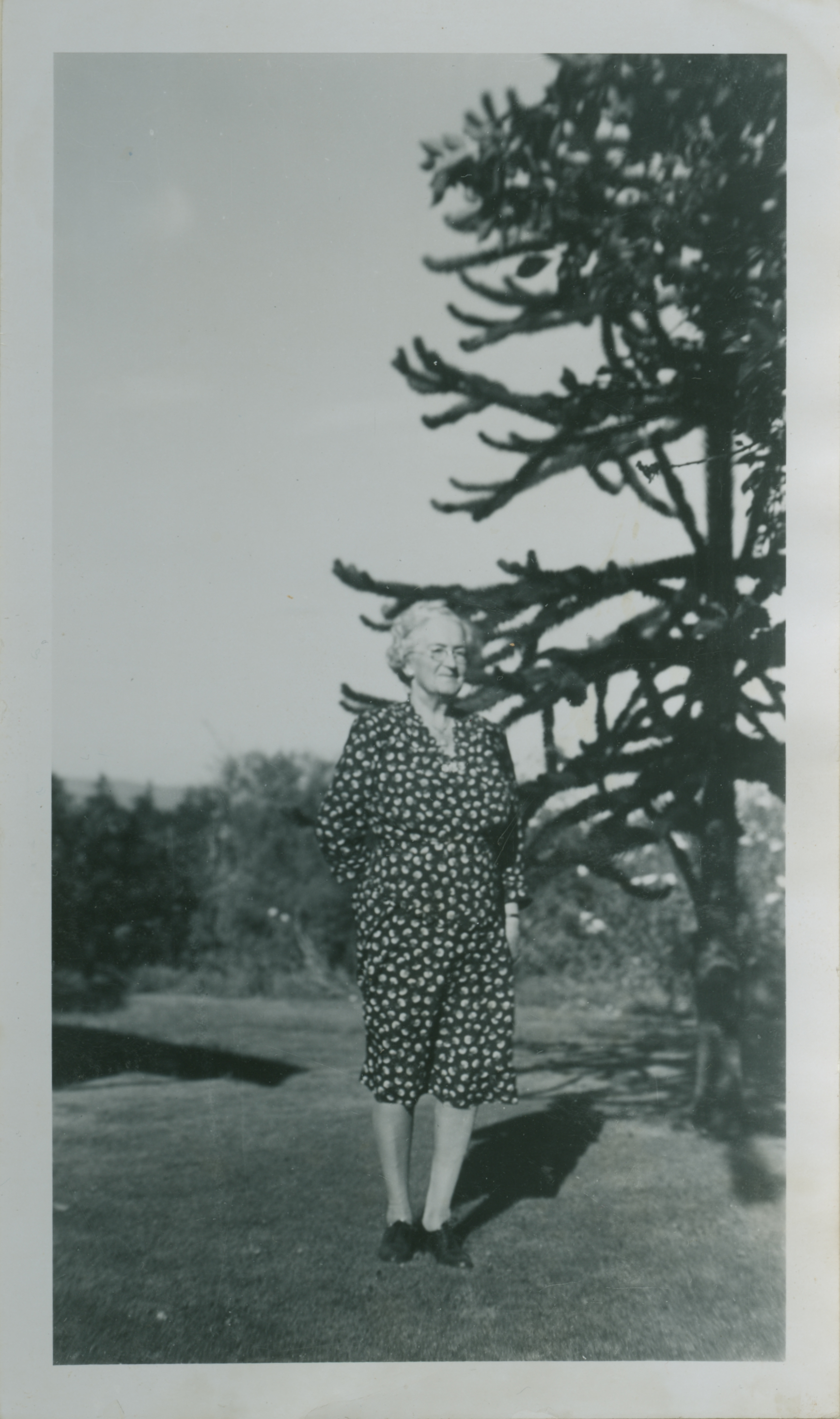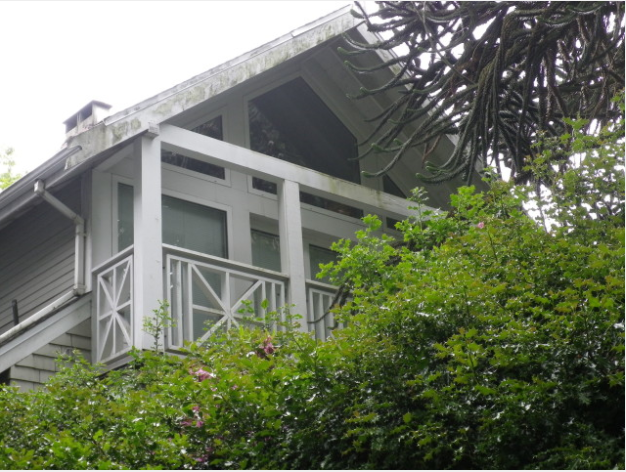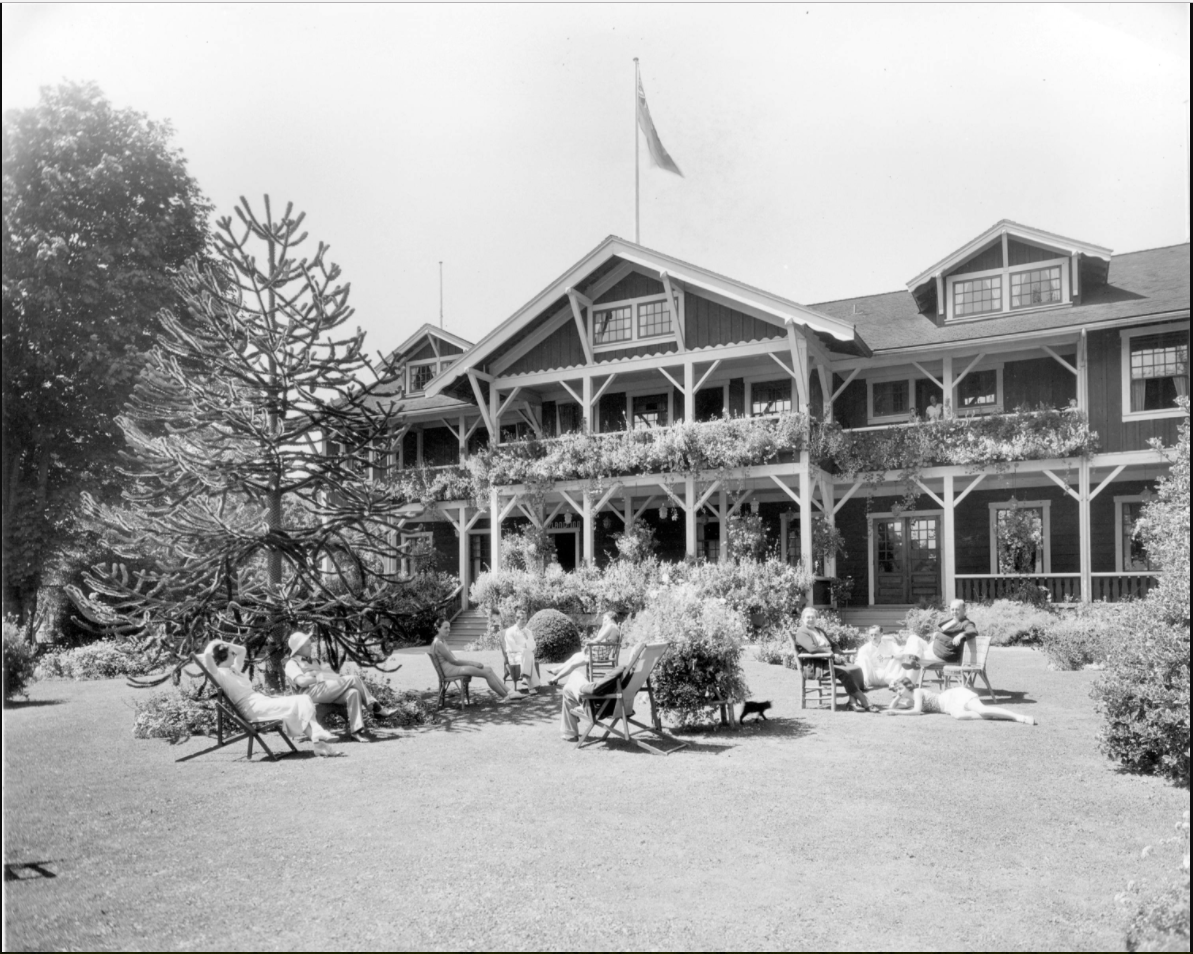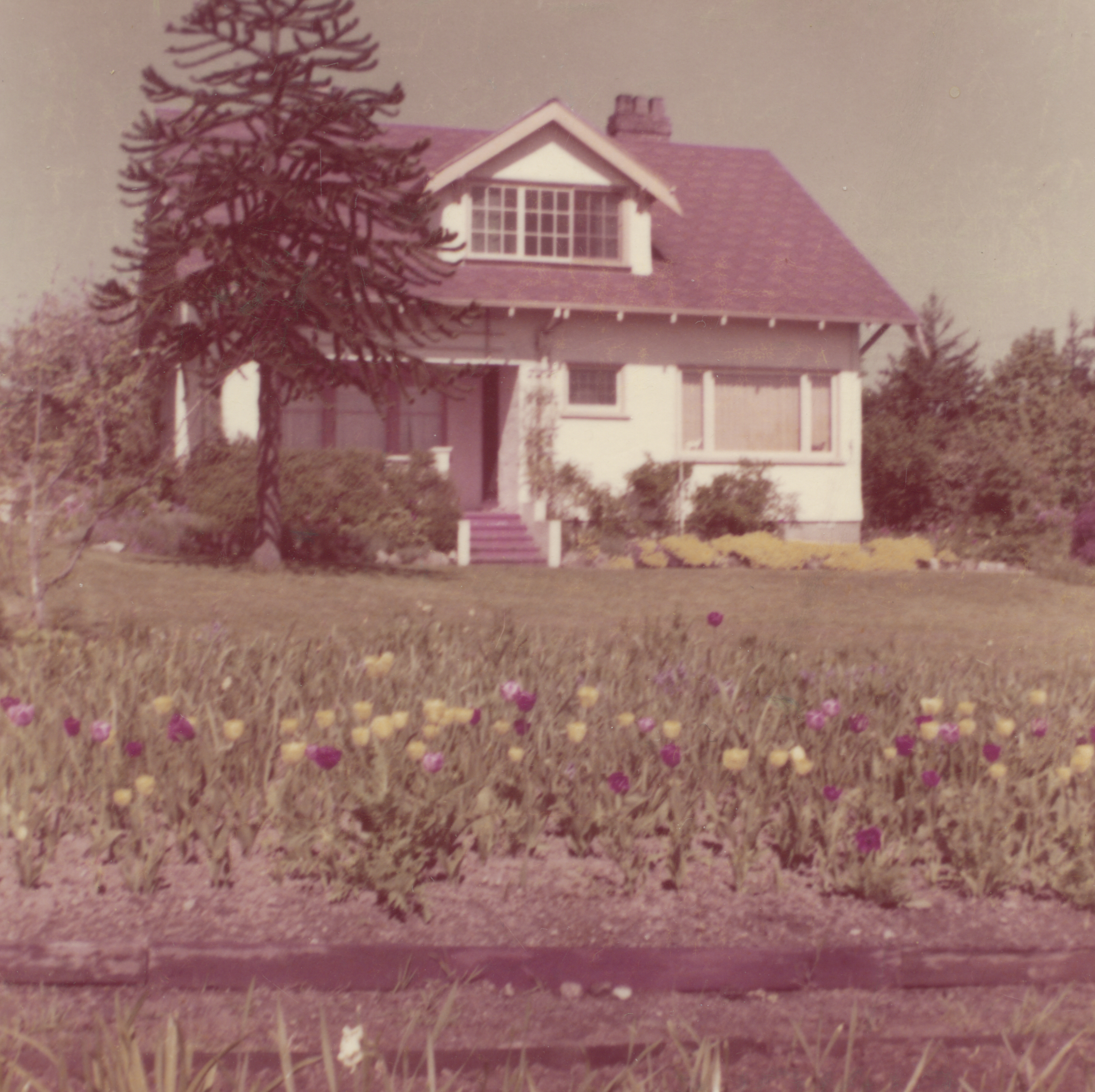We probably have more monkey puzzle trees in BC than in all of their native Chile. The quirky trees started arriving in gardens in the 1920s.
In 2012, I wrote a book called Sensational Victoria and one of my favourite chapters was Heritage Gardens. I visited and then wrote about large rich-people’s gardens like Hatley Park, and smaller ones like the Abkhazi Garden on Fairfield road built on the back of a love story. There was Carole Sabiston’s beautiful garden on Rockland Avenue anchored by a 100-year-old purple lilac tree, and the garden Brian and Jennifer Rogers created around their century-old Samuel Maclure designed horse stable. (Brian is the grandson of BT Rogers, the Vancouver sugar king, and another ardent gardener).

On the back cover of the book, there’s a photo of Nellie McClung standing in front of a giant monkey puzzle tree at the house she retired to at Gordon Head in 1935.
Lurancy Harris, the first female police officer in Canada, built her house on Venables in 1916. When I went to photograph it, the now two-storey house was dwarfed by a monkey puzzle tree that she’d planted in her front garden.

I’ve always had a thing for monkey puzzle trees—they seem to go particularly well with turrets, old houses and great stories. But I’ve never given them much thought until I was chatting with Christine Allen this morning about her upcoming talk for the Vancouver Historical Society next month. Christine—another Australian transplant—is a master gardener. She tells me that there was a huge craze for monkey puzzles trees here in the 1920s and 1930s.
“People were very proud of their monkey puzzle trees. It was so Victorian, they loved that kind of odd ball stuff,” she says. “There is a tiny post-war bungalow in my neighbourhood (Grandview) where somebody planted two massive ones on the south side of the house. That house gets no sun ever.”
Christine says the trees got their name because even a monkey would find it a puzzle to climb.

Christine says that another reason why these Chilean pines were so popular is because of Vancouver’s mild climate that allows us to grow anything from arctic tundra plants to palm trees.
But it’s not just people, towns are proud of them to. The tiny town of Holberg on Vancouver Island boasts the world’s tallest monkey puzzle tree. I have no idea how tall it is now, but in 1995 it was measured at 77 feet—that’s higher than a seven-storey building.

© All rights reserved. Unless otherwise indicated, all blog content copyright Eve Lazarus.




25 comments on “Vancouver’s Monkey Puzzle Tree Obsession”
When I visited Vancouver from the Okanagan as a child there were two plants that really stuck out as unusual and representative. The first was the mophead hydrangea in blue and the second was the monkey puzzle tree.
It has always irked me to hear people calling them monkey trees, although I can see why they make that mistake and I forgive them their iggorance.
Growing up, we referred to them as Monkey trees, with the interpretation that monkeys couldn’t climb them. (My little 5 year old brain wondered why monkeys couldn’t climb them because I would see monkeys on television in old movies climbing everything! Was it because the branches were too prickly? etc). More commonly now they are referred to as monkey TAIL trees, which makes more sense, as the branches do look like tails. Whatever the name, it’s all monkey business!
BTW, my grandparents lived in the west end in the ’60’s (The Nicola, 1101 Nicola Street), and as with all these old time buildings, there was a garden, and it, too had an Araucaria araucana. I haven’t walked by in over 20 years, but back then I didn’t see it.
That is really neat history! We called them monkey trees too. My paternal grandparents moved to Vancouver from Saskatchewan in 1941, and after working a few years were able to purchase a lovely old house at 3177 E 22nd Avenue in Vancouver. It had 2 gigantic monkey trees in front which I always admired as a child. My grandparents moved in 1974 but every time we drove past the house, we admired the trees until sadly they were taken down sometime in the 1990’s I believe. We never knew why, as the old house is still standing. It was a sad day for us.
We used to pinch each other whenever we saw them, which in Point Grey was very often.
The first monkey puzzle tree I saw was on 12th Avenue across from Vancouver City Hall and I was quite delighted by what to me was a most unusual tree. Ornamental trees weren’t common when I was growing up in Edmonton! I’m still happy to spot them — a hotel where we stayed in Scotland had two enormous ones on their immaculately-kept grounds.
Always wondered what they were – Chilean Pine – now I know, & thank you.
I lov these trees. I abscribe my lov because of Henri Rousseau. His art has a surreal yet percise line, border style that is ordered. The tree seems perfectly “neat” unlike other northwest greens. My first encounter was at Van Dusen gardens a few short years ago. A natural center of a maze!
Monkey tree, monkey tree, can’t pinch me b.a.a.a.c.k
Try and imagine the huge forests of monkey puzzle trees in southern Chile! That’s where they originate, and most of the large trees you see in front of great old houses would probably have come as seedlings in ships coming in from the great port city of Valparaiso. I love the English name – in French, we just use the Latin term – araucaria.
Where I grew up in East Van, there was a house with a huge monkey tree in front of it. We couldn’t see the house as it was behind a tall hedge but you could see the tree! Years later I discovered that the house had been the first house in Grandview, when I read “Vancouver The Way It Was by Michael Kluckner, one of my favourite books!
The famous trees alluded to on Northern Vancouver Island were located in Ronning Garden, near Holberg. There is an article about Ronning Garden and the monkey puzzle trees here: http://undiscoveredcoast.blogspot.com/2013/09/ronning-garden-labour-of-love-to.html .
Try and imagine the huge jungle of monkey puzzle trees in southern Chile! That’s where they originate, most of the big trees you see in front of the big old houses may have been seedlings on ships from the big port city of Valparaiso. I like the English name – in French, we only use the Latin word
I read the Sensational Victoria book. I realize the situation than. But Monkey puzzle tree is awesome to look.
My mother grew up in Vancouver in the 40s in a house on NW Marine Dr. with a large one in front. She had a newspaper article showing the tree in front of her house described as “the oldest and finest monkey puzzle tree in Vancouver”. I saw it as a child in 1967 but it is no longer there.
We lived in Portland where there is a fair obsession with them including a local tree registry that maps all the larger trees. In my mother’s honour we planted 1 that didn’t make it and another that grew prolifically (18″/year to 20 feet so far).
Reportedly, in Portland a ship brought a bunch of small sapplings from Chile for the world’s fair and these were given to all comers. So the oldest in the Pacific NW are supposed to date from this time.
Not so sure that we’d have the “world’s tallest” monkey puzzle tree. After all, most of the old ones got here as saplings in the hold of ships coming in from Chile…. where there are forests of them, including, I’m sure, the tallest one of the world…. somewhere in there. These unresearched claims give me chills everytime I see one.
You’re absolutely right Maurice, and I’m counting on you to find the world’s tallest monkey puzzle tree – it may require a trip to Chile!
So very interesting as all your articles are Eve.
Thanks Mariynn, glad you enjoyed it!
My Grandparents, Preston and Mabel Sharpe, had a very very large Monkey Puzzle tree in their front yard in Vancouver : 1990 West 19th Street. As a young child I was told that it was the largest in Vancouver.
Hello Maye. The tree is still growing strong. Stop by and see it one day. Anne Giardini
The rubber tree seedlings is tall, growing to 100 feet, and impressively wide, as its aerial roots reach the ground. Its leaves are smooth, dark and shiny; its bark is light-colored.
[…] I was driving along Lynn Valley Road for probably the hundredth time this year, stopped at the traffic lights at Fromme. The Lynn Valley Care Centre is on the corner there, sitting behind a stone fence and a very big monkey tree. […]
You West coasters think you’re the only ones in Canada that can grow monkey puzzle trees LOL, there’s many of them in Nova Scotia in different parts of the province so don’t act like you’re the only place that can grow them
I have a female tree. It is about 65 years old. Only once it was like 55 years old did It produce fertile nuts. How many I get each year differs, but every nut zi plant produces a tree. I find monkey puzzle trees in my yard and dig them up. I give them to a garden group to sell in March raising funds for a cancer center. They sell them for $5 each. My tree has produced male parts as well as female which is rare. The past 5 years about 10-15 male parts appeared. This year, about 50 or more male parts. I am happy to give trees to any of you who want if you are in the Seathle area – or happy to give you a nut to grow your own.
I have several monkey puzzles on my farm just outside Squamish BC. They have survived -20 several times since I planted them. I have quite a tree collection of rare trees but my monkey puzzles are the ones my guests talk about.